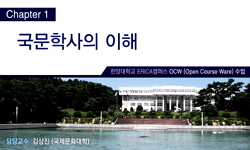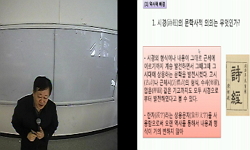The History of Korean Literature(國文學史), written by Nason(羅孫) Kim Dong-Wook(金東旭), focuses on the metadiscourse represented by the Motherland and the Nation. And the comparative literature method between Korea and Japan was applied. Th...
http://chineseinput.net/에서 pinyin(병음)방식으로 중국어를 변환할 수 있습니다.
변환된 중국어를 복사하여 사용하시면 됩니다.
- 中文 을 입력하시려면 zhongwen을 입력하시고 space를누르시면됩니다.
- 北京 을 입력하시려면 beijing을 입력하시고 space를 누르시면 됩니다.

나손(羅孫) 김동욱(金東旭)의 『국문학사』 = A Study on the History of Korean Literature by Nason(羅孫) Kim Dong-Wook(金東旭)
한글로보기부가정보
다국어 초록 (Multilingual Abstract)
Nason(羅孫) made six basic positions to describe the history of Korean literature. It is ① The concept and category of literature. ② The tradition of literary history. ③ The descriptive attitude of literary history. ④ The method of writing of literary history. ⑤ The view of literary history. ⑥ The direction of literary history. In ①, included Chinese literature in the history of Korean literature according to the concept of literature in the East, and excluded oral literature enjoyed by words. However, Yadam(野談) and SamGukYuSa(三國遺事) were included in the history of Korean literature in that they were recorded in letters. In the tradition of literary history[②] and the direction of literary history[⑥], Nason noted the role of upper-class geniuses who emphasized our words and writings. He also emphasized the need to create a new Koreanology that combines upper-class geniuses and lower-class people who actively enjoyed our words and writings. However, his literary history did not provide such details. The descriptive attitude of literary history[③] and the method of writing of literary history[④] used a comparative literary method based on national pride. The direction of literary history[⑥] tried to mix the classical scholar scholarly spirit with the dynamic Hwarangdo(花郞道). However, Hwarangdo is connected with the Japanese samurai spirit, and the classical scholar scholarly spirit shows limitations in that it could not escape from the ideology that was passed down from Takahashi Doru(高橋亨) and Donam(趙潤濟).
The History of Korean Literature(國文學史), written by Nason(羅孫) Kim Dong-Wook(金東旭), focuses on the metadiscourse represented by the Motherland and the Nation. And the comparative literature method between Korea and Japan was applied. These two are the most prominent features in the history of Korean literature written by Nason. However, the metadiscourse and comparative literature contradict each other. The fact that the periodization in history, which is the core of literary history, was based on the royal family in the history of Korean literature, was the result of not being able to overcome the contradiction between the two.
Nason(羅孫) made six basic positions to describe the history of Korean literature. It is ① The concept and category of literature. ② The tradition of literary history. ③ The descriptive attitude of literary history. ④ The method of writing of literary history. ⑤ The view of literary history. ⑥ The direction of literary history. In ①, included Chinese literature in the history of Korean literature according to the concept of literature in the East, and excluded oral literature enjoyed by words. However, Yadam(野談) and SamGukYuSa(三國遺事) were included in the history of Korean literature in that they were recorded in letters. In the tradition of literary history[②] and the direction of literary history[⑥], Nason noted the role of upper-class geniuses who emphasized our words and writings. He also emphasized the need to create a new Koreanology that combines upper-class geniuses and lower-class people who actively enjoyed our words and writings. However, his literary history did not provide such details. The descriptive attitude of literary history[③] and the method of writing of literary history[④] used a comparative literary method based on national pride. The direction of literary history[⑥] tried to mix the classical scholar scholarly spirit with the dynamic Hwarangdo(花郞道). However, Hwarangdo is connected with the Japanese samurai spirit, and the classical scholar scholarly spirit shows limitations in that it could not escape from the ideology that was passed down from Takahashi Doru(高橋亨) and Donam(趙潤濟).
참고문헌 (Reference)
1 김태식, "화랑세기, 또 하나의 신라" 김영사 2002
2 신재홍, "화랑세기 역주" 태학사 2009
3 국립중앙박물관, "호모 사피엔스" 국립중앙박물관 2021
4 김준형, "한국문학사 서술의 경과-고전문학사 서술을 중심으로" 민족문학사연구소 (44) : 156-196, 2010
5 김석하, "한국문학사" 신아사 1975
6 김준영, "한국고전문학사" 형설출판사 1971
7 사회과학원, "조선문학사 1-15" 사회과학출판사 2000
8 안확, "조선문학사" 한일서점 1922
9 이명선, "조선문학사" 조선문학사 1947
10 김준형, "이명선의 『조선문학사』와 유물사관" 우리어문학회 (23) : 87-128, 2004
1 김태식, "화랑세기, 또 하나의 신라" 김영사 2002
2 신재홍, "화랑세기 역주" 태학사 2009
3 국립중앙박물관, "호모 사피엔스" 국립중앙박물관 2021
4 김준형, "한국문학사 서술의 경과-고전문학사 서술을 중심으로" 민족문학사연구소 (44) : 156-196, 2010
5 김석하, "한국문학사" 신아사 1975
6 김준영, "한국고전문학사" 형설출판사 1971
7 사회과학원, "조선문학사 1-15" 사회과학출판사 2000
8 안확, "조선문학사" 한일서점 1922
9 이명선, "조선문학사" 조선문학사 1947
10 김준형, "이명선의 『조선문학사』와 유물사관" 우리어문학회 (23) : 87-128, 2004
11 E. H. 카, "역사란 무엇인가" 까치 2015
12 세라 블래퍼 허디, "어머니의 탄생" 사이언스북스 2010
13 세라 블래퍼 허디, "어머니, 그리고 다른 사람들" 에이도스 2021
14 방띠겜, "비교문학" 주영사 1974
15 민족문학사연구소, "북한의 우리문학사 재인식" 소명출판 2014
16 김준형, "북한 고전문학사의 지향과 한계 -남북한 고전문학사 기술에서 동일한 지향이 가능한가?" 민족문학사연구소 (74) : 111-145, 2020
17 이명선, "민족문학과 민족주의문학" 신조선사 4 : 1947
18 민족문학사연구소, "문학사를 다시 생각한다" 소명출판 2018
19 나손김동욱선생 회갑기념문집간행위, "나손김동욱선생 회갑기념문집" 열화당 1982
20 김양선, "나손 김동욱 연구 : 국문학 연구와 「국문학사」를 중심으로" 공주대학교 교육대학원 2002
21 이병기, "국문학전사" 신구문화사 1959
22 김동욱, "국문학사" 일신사 1976
23 우리어문학회, "국문학사" 수로사 1948
24 김동욱, "교정본 국문학사" 일신사 1986
25 박노자, "거꾸로 보는 고대사" 한겨레출판 2010
26 김사엽, "개고 국문학사" 정음사 1954
27 김동욱, "韓國文學 硏究의 몇 가지 課題" 인문학연구원 46 : 213-223, 1982
28 劉知幾, "史通" 역사비평사 2014
29 윤대석, "‘친일문학’과 문학교육" 한국문학교육학회 (34) : 9-30, 2011
30 강상대, "‘녹족부인’ 스토리텔링을 위한 원형서사 연구" 한국문예창작학회 9 (9): 167-192, 2010
동일학술지(권/호) 다른 논문
-
- 근대서지학회
- 이윤석
- 2022
- KCI등재후보
-
해방 후 임순득의 ‘여성해방 의식’과 북한의 ‘장르문학’ 창작: 오체르크와 뿌블리찌스찌까에 대하여
- 근대서지학회
- 이슬아
- 2022
- KCI등재후보
-
나손 김동욱 선생의 기녀사: ‘기녀/기생/창기’ 개념의 정의
- 근대서지학회
- 신현규
- 2022
- KCI등재후보
-
- 근대서지학회
- 한상언
- 2022
- KCI등재후보




 스콜라
스콜라







